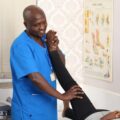What is Persistent Pain?
Persistent pain is any pain that goes on for longer than would be expected after an injury or illness. Pain is initially produced when we have an injury or to let us know something is wrong. When we have an injury our bodies produce chemicals which cause our pain nerves to become more sensitive so that we get pain as a “warning sign” before we injure ourselves further. Normally, once the injury gets better our nerves go back to normal and the pain stops.
Unfortunately, in some people their nerves stay too sensitive. This means that they continue to get pain even though there is no longer any problem with the body’s tissues. This can also mean that they have to reduce the amount of activity that they do. Sometimes people also become concerned about the cause of the pain and worry about damaging things more. Unfortunately, this causes the nerves to become even more sensitive, often meaning that the pain gets worse and starts to affect different parts of the body.
Not everyone develops persistent pain following an injury. Some people find that their symptoms start without any obvious cause. We know that other things can also cause the nervous system to become too sensitive. For example, we know that poor quality sleep, low mood and stressful life events (such as a bereavement or losing a job) can cause the pain nerves to become too sensitive.
For other people, long standing health problems (such as breathing problems or arthritis) can cause people to stop exercising as much as previously. Not only does this mean that the body becomes less fit, the nerves are no longer used to doing activities and can start to send pain messages when doing activities that used to be painless. This is known as the persistent pain cycle.
How Pain Works
Scientists are gradually unravelling the processes within the body that lead to the unpleasant sensation of pain. Here’s a simple explanation of what happens when you feel one type of pain.
- You prick your finger on something sharp. This causes tissue damage, which is registered by microscopic pain receptors (nociceptors) in your skin. Each pain receptor forms one end of a nerve cell (neurone). It is connected to the other end in the spinal cord by a long nerve fibre or axon. When the pain receptor is activated, it sends an electrical signal up the nerve fibre.
- The nerve fibre is bundled with many others to form a peripheral nerve. The electrical signal passes up the neurone within the peripheral nerve to reach the spinal cord in the neck.
- Within an area of the spinal cord called the dorsal horn, the electrical signals are transmitted from one neurone to another across junctions (synapses) by means of chemical messengers (neurotransmitters). Signals are then passed up the spinal cord to the brain.
- In the brain, the signals pass to the thalamus. This is a sorting station that relays the signals on to different parts of the brain. Signals are sent to the somatosensory cortex (responsible for physical sensation), the frontal cortex (in charge of thinking), and the limbic system (linked to emotions).
The end result is that you feel a sensation of pain in your finger, think ‘Ouch! What was that?’ or something similar, and react emotionally to the pain; e.g. you feel annoyed or irritated.
However, you will probably have reacted involuntarily even before you were consciously aware of the injury. In sudden strong pain like that generated by pricking your finger, a reflex response occurs within the spinal cord. Motor neurones are activated and the muscles of your arm contract, moving your hand away from the sharp object. This occurs in a fraction of a second — before the signal has been relayed on to the brain — so you will have pulled your arm away before even becoming conscious of the pain.
Research suggests that because pain involves both the mind and the body, mind-body therapies may have the capacity to alleviate pain by changing the way you perceive it. How you feel pain is influenced by your genetic makeup, emotions, personality, and lifestyle. It’s also influenced by past experience. If you’ve been in pain for a while, your brain may have rewired itself to perceive pain signals even after the signals aren’t being sent anymore.
The Benson-Henry Institute for Mind-Body Medicine at Harvard-affiliated Massachusetts General Hospital specializes in helping people learn techniques to alleviate stress, anxiety, and pain. Dr. Ellen Slawsby, an assistant clinical professor of psychiatry at Harvard Medical School who works with patients at the Benson-Henry Institute, suggests learning several techniques so that you can settle on the ones that work best for you. ”
How do I know if my pain system is being over protective?
First things first: get yourself thoroughly checked out by a qualified health professional. They will know the right questions to ask and tests to do to make sure you have not got a serious condition. Most people reading this will have seen not one but many health professionals. Having a serious condition doesn’t mean that this stuff doesn’t apply, it just means you have to do other things as well to treat the condition.
Once you have been cleared of a serious condition, you are set to go!
Practice makes perfect! If you have had pain for more than a few months, then your pain system will be more efficient at producing pain. This is what happens over time – your system becomes more sensitive. It learns pain. Nerve cells in your spinal cord and brain change their properties to be more responsive. Exactly the same thing happens when you learn a new skill, such as playing the piano – nerve cells change their properties to be more responsive. The process is the same. The nerve cells involved are different.
You will know your pain system is becoming overprotective when:
- Your body starts to feel more sensitive than it did.
- Activities that used to cause a little pain now cause a lot of pain.
- Activities that were usually not painful, start to become painful.
These things also happen straight after an injury – you might be able to see how excellent they are at protecting your tissues. They often resolve when the tissues heal. However, when the pain remains and the sensitivity sets in, it can feel like your injury is getting worse, but that is actually very unlikely.
Other signs your pain system is becoming over protective include:
Your pain might spread, or it might move from one side of your body to the other, or from one location to another, or new spots become sore.
Your movement system starts to get in on the act. Remember that movement is another great way to protect. You might find some movements become more difficult. You might feel stiff.
You might have muscle spasms. They can be really frightening, particularly if you don’t understand them or know what caused them. They are another way your body protects a painful area. They are almost never a sign that you have damaged something.
You might even find you become more sensitive to things that don’t seem related to your body – loud noises, unusual smells – slightly annoying people can become very annoying people.
All these things show that your system is ‘on alert’. Pain can actually be turned up and down by your thoughts, feelings and other things going on in your life – things that actually have nothing to do with the painful body part!
Pain scientists understand how this works and it actually makes terrific sense. However, many people don’t understand it – even some health professionals. One thing that we know absolutely for certain, 100%, is that an over protective pain system is NOT a sign you have a weak personality or a weak mind; it does NOT mean you are going crazy and it does NOT mean your injury is getting worse or your body is falling apart. It means your body is doing too good a job of protecting itself.
When our pain system becomes over protective, it stops us doing the movements, activities and other things and that are actually necessary for recovery.
But we know you can’t ‘just beat pain’ because this sensitive system that is producing pain is also the system that helps to make you you! Everyone can learn new ways of retraining their pain system to be less protective. So, now is as good a time as any to get started.
How can I train my pain system to be less protective?
There are actually many ways to retrain your pain system, but they all begin with understanding your pain. In fact, understanding that pain is much more complex than a signal from damaged tissues is one of the best things you can do to start your journey to recovery – many people say that their pain began to reduce as soon as they understood it better.
The goal is to re-train your pain system back to providing protection when you need it, but not when you don’t.
Start by developing an accurate understanding of your pain system and how it can become overly protective. This overly responsive pain system is the result of the amazing ability of all of our body systems to adapt. Sometimes when injured tissues heal, they don’t look the same as they did before your injury – think of a scar from an old cut – but they can still adapt to being stronger and fitter and less painful.
Understanding is very important when it comes to pain because pain depends on what it means to you. If you can change the meaning of your pain, then you can change your pain!
Knowledge is power and really knowing that your system is overprotective, and really understanding that pain is affected by thoughts, feelings, moods, sayings – the list of things is just way too long – pain can be turned up by anything that can trigger a protection response and turned down by anything that makes your system feel safe. You might find that with understanding comes a renewed confidence to move – even when it hurts – and to nudge your system little by little.
Find a good coach. A good coach will help you understand your pain better and to identify the things that make your pain worse and things that make it better. A great coach, with training in pain science (you can ask your physio, OT, doctor or nurse if they have this), will teach you how to plan your recovery, one week at a time, and encourage you to persevere and ‘train smart’. Remember your coach can guide you, but this is a journey that you have to take.
You can start without a coach too – moving just a little more than you normally would and doing something that lifts your heart rate – little by little – is actually the best way to train your system to be less protective. You might have to be patient – sometimes it is slow going and you can have set-backs – but remember pain is protecting you, not telling you that you have damaged yourself.
Being creative in managing your journey is likely to help. Our brains love to get new information or to be reminded of situations or activities that were fully of safety messages. Again, your coach can give you some ideas
How do I know if I am safe to move?
Movement is the most critical pathway to recovery and it is almost always safe to move.
Get a health professional to check you over and give you the ‘OK’ to move. A health professional will be able to tell you if you are the very rare case for whom it is not safe to move. A health professional who understands modern pain science can talk you through why it is safe for you to move even though you have pain. They can tell you how much you can push it, how you can start to ‘read the signs’ that you are getting close to triggering your pain system. Remember – the pain system will protect the tissues of your body!
They can also help you understand that many things found on scans are perfectly normal and common, even in people who do not have pain.
Start with something slightly more intense than you currently do. If you are like many people with persistent pain, you are not doing much in the way of activity and movement. It is usually best to start gently with a simple movement such as walking. Some people with persistent pain already do a massive amount of exercise (some are Olympians!). Then it can be a case of mixing exercise with other cues and ‘training smart’.
Injuries heal, and your body’s tissues adapt amazingly well to the demands of life. Even if things don’t heal perfectly, they nearly always return to close to normal function. That doesn’t mean we stop hurting. Back pain in particular can be really severe even when there is no detectable tissue damage at all!
Here are some facts that have helped other people gain confidence to get moving:
‘Disc bulges’ are so common in people WITHOUT back pain that many scientists think they are not abnormal but a common and normal part of ageing? 50% of 40 year olds WITHOUT back pain have a disc bulge! You can learn more about common back scan findings in people without back pain here.
If you were injured more than two months ago then a vast amount of healing has already happened. Don’t underestimate how magnificent and irresistible this healing capacity is.
Knowing and believing that you are safe needs repetition and practice, and ‘stacking up the wins’, as you teach your overprotective pain system that it does not need to be so protective. Watch the tame the beast pain video below;





